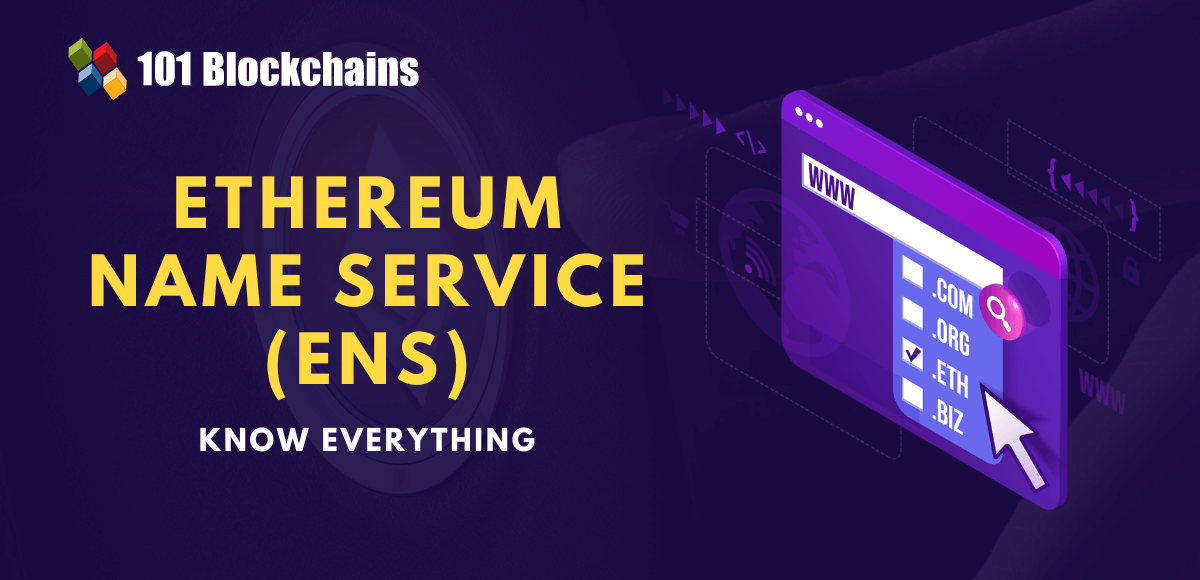Before the introduction of domain names, users had to type the full IP address of the website to access it. IP addresses include a lengthy combination of numbers and dots, which could be difficult to remember for the average user. However, the introduction of the Domain Name System in 1983 changed the narrative of internet accessibility.
The functionalities of DNS primarily focused on the alignment of IP addresses and human-friendly domain names. As a result, users could access websites by entering the website’s name rather than lengthy IP addresses. How does the ENS Ethereum Name Service relate to DNS? The following post offers an answer with a detailed introduction to ENS and its architecture.
Reasons for Introducing Ethereum Name Service
The advancements in cryptocurrencies and blockchain have stunned enterprises across various sectors with unique value-based benefits. Blockchain has been a crucial contributor in discussions around web3 development as it offers the decentralized infrastructure required for technologies of the future. The details of the Ethereum Name Service explained for beginners must emphasize the underlying reasons for introducing ENS in the first place. Irrespective of the technological advancements in crypto and blockchain, most of the systems use a similar setup as the old IP address model.
For example, you need the public key of a person’s wallet to send cryptocurrencies to their wallet address. The wallet addresses are similar to IP addresses, albeit featuring a string of letters and numbers. Therefore, the crypto domain needs a human-friendly alternative like Ethereum Name Service.
Want to become a Cryptocurrency expert? Enroll Now in Cryptocurrency Fundamentals Course
Definition of Ethereum Name Service
The basic reason for introducing ENS in the world of crypto and blockchain revolves around the complexity of user experiences. What is the ENS, and how does it solve the problem? Before you try to find the benefits of Ethereum Name Service, it is important to learn its definition. Ethereum Name Service or ENS is a distributed and open naming system with the option for expanding according to user needs. As the name implies, Ethereum serves as the foundation of ENS. The primary goal of ENS focuses on mapping human-readable names to different machine-readable identifiers in blockchain and crypto. The important machine-readable identifiers include crypto metadata, cryptocurrency addresses and content hashes.
Another important feature of ENS refers to reverse resolution. It can help in associating metadata, including interface descriptions and canonical names, with Ethereum addresses. The concerns regarding “Is Ethereum Name Service safe?” also qualify as important highlights in basic descriptions of ENS. Interestingly, the foundations of Ethereum Name Service offer the assurance of safety. ENS is similar to DNS in terms of goals, albeit with significant differences in architecture for incorporating capabilities and constraints by Ethereum.
Excited to learn the basic and advanced concepts of Ethereum technology? Enroll Now in The Complete Ethereum Technology Course
Working of Ethereum Name Service
The introduction to Ethereum Name Service also draws attention to the fundamentals of its working. ENS follows the approach of hierarchical names, referred to as domains, separated by a dot. For example, “john.eth” is an Ethereum Service Name domain. The owner of this domain would have complete control over the subdomains included in it. It is important to remember that the ‘.eth’ and ‘.test’ domains are under the ownership of smart contracts, referred to as registrars. The registrars serve an important role in ENS Ethereum for specifying the rules that could govern the allocation of subdomains. Any user can become the owner of a domain for personal use in compliance with the rules specified in the registrar smart contracts.
The working of Ethereum Name Service also involves another unique highlight in the support for importing DNS names. It means that you can import your DNS names for use on ENS. In addition, ENS allows domain owners at any level to the configuration of subdomains for personal uses or others. For example, the owner of the ‘john.eth’ domain could create a subdomain named ‘pay.john.eth’ and configure it according to their requirements.
The benefits of Ethereum Name Service are also visible in the deployment of ENS on the Ethereum network as well as other test networks. Furthermore, ENS could detect the networks on which you use end-user applications or libraries such as the ensjs JavaScript library. Subsequently, it could utilize the ENS deployment on the identified network. Users could try exploring ENS functionalities with the ENS Manager app or through the different ENS-powered applications.
Want to learn the basic and advanced concepts of Ethereum? Enroll in our Ethereum Development Fundamentals Course right away!
How is ENS Different from DNS?
The concept of the internet’s Domain Name System or DNS emerged for the first time in the 1970s in the research efforts by an American computer scientist, Elizabeth Feinler. A few years later, in 1983, another American computer scientist, Paul Mockapetris, used Feinler’s research to create the Domain Name System. The difference between DNS and ENS is important for answering “Is Ethereum Name Service safe?” as cryptocurrencies and blockchain-based assets are scarce and valuable. The Domain Name System and ENS help in defining the resolution of specific operations on web2 and web3.
DNS works by converting the IP address of a web server into human-readable names, referred to as URLs. On the other hand, Ethereum Name Service transforms Ethereum addresses into human-readable strings, which look like URLs. Therefore, you can notice that the ENS Ethereum is similar to DNS in terms of certain functionalities. Both of them work just like a phonebook and could help you obtain the number to contact a specific user. It is also important to understand how DNS serves an important role in the seamless working of web2 systems. The Domain Name System is a significant highlight in the collection of internet protocols that enable uninterrupted internet accessibility.
On the other hand, the growth of web3 has called for new advancements through the decentralization of the web. However, web3 encounters significant setbacks in adoption, such as long addresses, which introduce complexities in user experiences. The basic highlights in Ethereum Name Service explained how it could resolve the problem of long addresses. It aims to offer simpler ways for people and applications to read and share crypto addresses in the emerging web3 landscape. The maturity of web3 could foster further improvements in prospects for more ENS protocols.
Build your identity as a certified blockchain expert with 101 Blockchains’ Blockchain Certifications designed to provide enhanced career prospects.
The Architecture of Ethereum Name Service
The next significant highlight in an introduction to Ethereum Name Service would focus on its architecture. You can find two important components in the architecture of ENS. Here is an outline of the principal components of ENS architecture.
The ENS Registry is one of the crucial components in the architecture of Ethereum Name Service. It includes a single, smart contract for ensuring effective maintenance of a list of all the ENS domains and subdomains. ENS Registry plays a vital role in offering benefits of Ethereum Name Service by facilitating storage for three important pieces of information. The registry includes information about the owner and resolver of the domain, as well as caching time-to-live for each record in the domain.
The owner of domains in the ENS Registry could be an external account or smart contracts. Another significant highlight of the ENS Registry refers to the smart registrar contracts, which exercise ownership over domains. The registrar contracts could issue subdomains of their domain to users who comply with the rules specified in the contracts. On top of it, the ENS Registry allocates certain privileges to domain owners, such as changing ownership of subdomains. Domain owners can specify the TTL and resolver for the concerned domain. In addition, domain owners can also transfer the domain ownership to other addresses. The working of the ENS Registry is quite simple as it focuses only on mapping domain names to corresponding resolvers.
The detailed explanation for “What is Ethereum Name Service” would also focus on the role of resolvers in its architecture. Resolvers help in facilitating the actual process of translation of names into addresses. Smart contracts which follow specific standards could assume the role of resolvers in Ethereum Name Service architecture. Users can avail of general-purpose resolver implementations for simple requirements, such as allocating infrequently modified addresses to a domain name. Resolvers can identify methods in each record type, such as IPFS content hashes or cryptocurrency addresses, for facilitating records of the concerned type.
Resolvers have to define new record types through the EIP standardization process without any need for changes in ENS Registry or existing resolvers to support them. It is important to note that resolving domain names in ENS follows a two-step approach. In the first step, users have to query the registry to identify the resolver associated with the concerned name. Subsequently, you have to seek the answer to your query from the resolver.
Start learning about Cryptocurrencies with World’s first Cryptocurrency Skill Path with quality resources tailored by industry experts Now!
Another notable highlight in the working of ENS Ethereum Name Service refers to the Namehash. ENS offers an effective approach for translating machine-readable identifiers in crypto and blockchain to human-readable names. However, the resource limitations in smart contracts create setbacks for direct interactions with human-readable names. How does ENS solve this problem? Ethereum Name Service deals completely with 256-bit cryptographic hashes. It works on deriving hash from a name alongside safeguarding the hierarchical traits by using the Namehash process. The Namehash process offers a representation of names suitable for exclusive use in ENS.
It is also important to note that Namehash follows a recursive process for creating a unique hash for valid domain names. Furthermore, the namehash for a domain also helps in obtaining viable namehash choices for subdomains. The recursive property of namehash helps in ensuring a hierarchical system in ENS without internal management of human-readable strings of text.
Importance of ENS
The final highlight in discussions around Ethereum Name Service fundamentals would reflect on the concerns of security. The responses to “Is Ethereum Name Service safe?” would draw references to how ENS is native to the Ethereum blockchain. As a result, it is less likely to encounter security problems like DNS systems. DNS follows a centralized approach for the storage of domains and names, thereby rendering them vulnerable to security breaches. On the other hand, the Ethereum blockchain could not destroy ENS records due to immutability. ENS can also improve user experiences by offering better transparency of names and addresses alongside ease of interaction.
Excited to know about how to become an Ethereum developer? Check the quick presentation Now on: How To Become an Ethereum Developer?
Final Words
The introduction to the fundamentals of Ethereum Name Service offers a detailed impression of their significance for web3. Accessibility is one of the prominent setbacks for the crypto and blockchain ecosystem right now. The average user cannot catch up with the concepts of wallet addresses and cryptography quickly. Therefore, the benefits of Ethereum Name Service can ensure that users can access cryptocurrencies and blockchain services without complicated identifiers. However, ENS is still in the nascent stages, and new protocols around ENS can introduce new functionalities. Learn more about Ethereum Name Service and how it can define the future of web3.
*Disclaimer: The article should not be taken as, and is not intended to provide any investment advice. Claims made in this article do not constitute investment advice and should not be taken as such. 101 Blockchains shall not be responsible for any loss sustained by any person who relies on this article. Do your own research!









